Master Class: Michelin-starred n/naka chefs on how to make the perfect onigiri

- Share via
As chef of n/naka, her celebrated California kaiseki restaurant in Palms, Niki Nakayama painstakingly and famously tries to never repeat a menu for any diner.
Nakayama and her sous chef and wife, Carole Iida-Nakayama, keep things simpler at home. One of their favorite things to cook? Onigiri, the traditional Japanese rice balls.
Onigiri are the PB&J of Japan. They’re packed in school and work lunchboxes and signal homey warmth: lightly seasoned rice stuffed with a filling (pickled ume and cod roe are popular options), shaped by hand, and wrapped in nori.
“My grandma used to make onigiri for us to sneak into Disneyland and eat instead of the burgers there,” Nakayama recalls, “so I always associate onigiri with fun and family. During the summer, we’d bring them on picnics in the park too. They’re super basic, but they’re the most comforting way of eating.”
Onigiri don’t show off the chefs’ talent for conceiving intricate kaiseki-style dishes, but Nakayama and Iida-Nakayama say they take this recipe as seriously as any other. And it is a perfect distillation of Nakayama’s understanding of and commitment to letting Japanese and Californian ingredients shine.
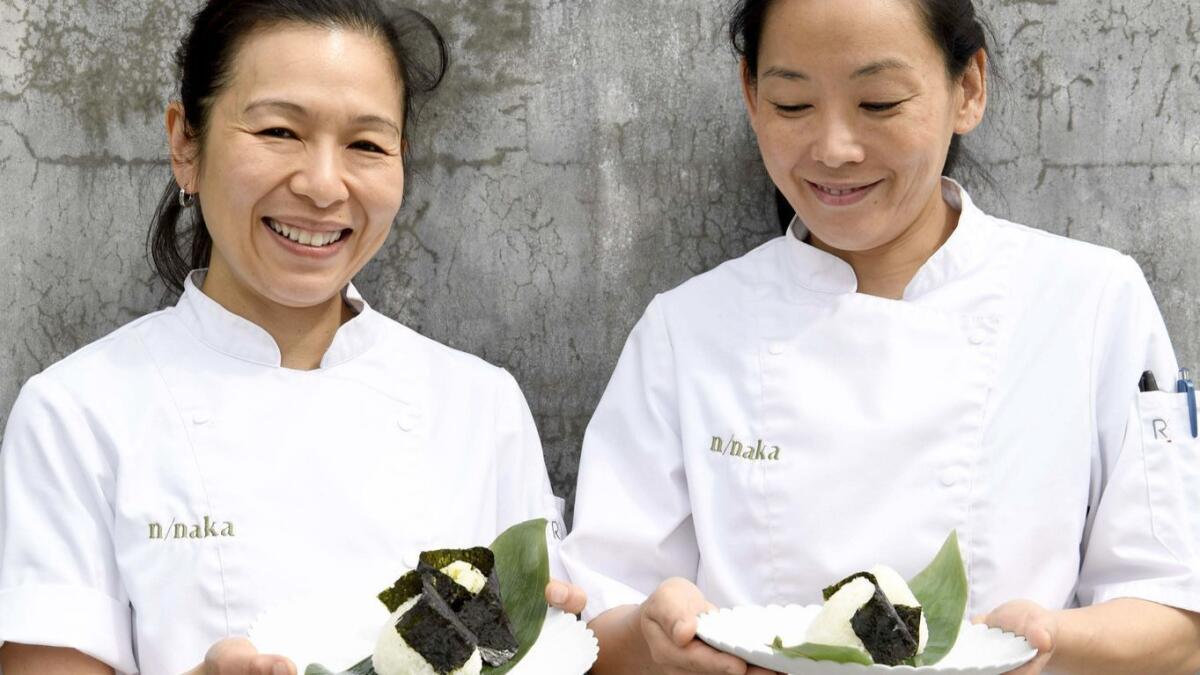
Here’s how Nakayama and Iida-Nakayama make perfect onigiri:
Ingredients
Nakayama uses a 50-50 blend of premium Japanese koshihikari rice and California short-grain rice. Both are pricier than supermarket rice, but she strongly suggests seeking out the very best rice — the dish, after all, is almost all rice. Nakayama buys Tokubetsusaibaimai Uonuma Koshihikari from Japan and Tamanishiki from California.
The nori is key too. “It has to be so crisp it crackles,” says Iida-Nakayama, “and it has to have flavor and fragrance.” They source their seaweed directly from Japan, but recommend looking for any nori labeled “ariake,” which is the highest grade.
Michelin Guide awards stars to n/naka and other restaurants; city shut out of three-stars »
As for the fillings, they suggest a trip to a Japanese market such as Mitsuwa, Nijiya or Marukai. Nakayama’s favorite filling is umeboshi, fermented plums, and Iida-Nakayama’s is mentaiko, pollock roe. They also stuff their onigiri with flaked smoked salmon; kombu they cure themselves; bonito seasoned with soy, sesame oil and mirin; and jarred tuna mixed with Kewpie mayonnaise.
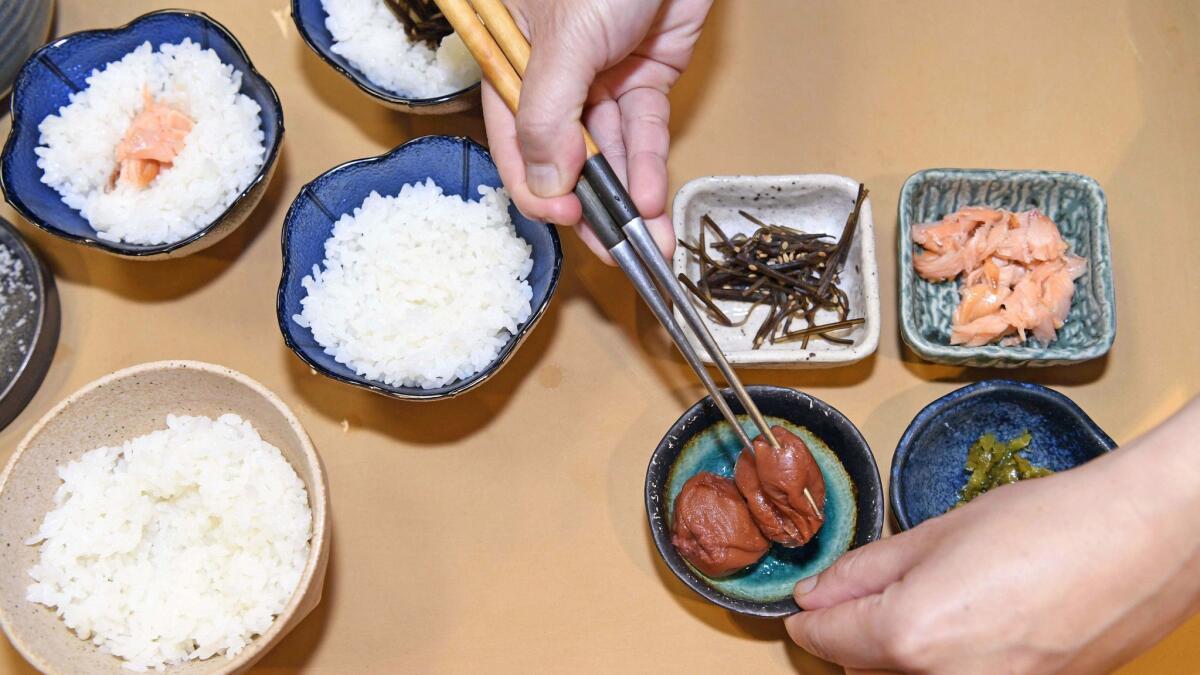
Tools
Although you probably have the basic tools to make onigiri, Nakayama and Iida-Nakayama suggest investing in a Japanese donabe, or rice pot. The inexpensive stoneware can be found at the same markets above and, they say, cook short-grain rice perfectly. The couple’s shortcut to shaping onigiri is scooping the rice into a Japanese rice bowl before shaping it.
Technique
The end goal of onigiri is chewy rice that’s just warm — neither too hot nor cold — wrapped with crisped nori. In flavor, there should be balance between the lightly salted rice and savory filling and the natural sweetness of the rice grains. To achieve that, follow Nakayama and Iida-Nakayama’s tips:
- Wash the rice in a colander set in a bowl. This method lets you see exactly when the water is clear and allows you to drain the rice quickly without losing any grains. Swish the rice in the water quickly and drain immediately because letting the rice sit in the washing water can make it absorb too much moisture; you will probably need to rinse the rice five times to get clear water.
- If you’re cooking with a “new crop” or fresh rice, which will be indicated on the bag and is usually available in Los Angeles stores in October, according to Nakayama, use 10% less water during cooking because the grains will have a higher moisture content.
- Soak the rice. It helps loosen and soften the kernels. If you don’t soak the raw grains, their centers can be too firm after cooking. Nakayama soaks her rice in cold, filtered water.
- Use your strongest burner when cooking the rice because you want to hit the rice with high heat as quickly as possible to help the grains expand fast through quick absorption of the boiling water.
- Cook the rice on the stove, not in a rice cooker. The timing on this stovetop rice technique requires a little trial and error with your stove’s heat, your pot and the freshness of your rice. The timings in this recipe work consistently for Nakayama (and in our test kitchen tests), but check on the rice as it cooks. There should be no water remaining in the pot and the rice grains should be shiny and evenly chewy.
- Be sure to mix the rice gently before shaping to let it breathe off a little steam and become fluffy.
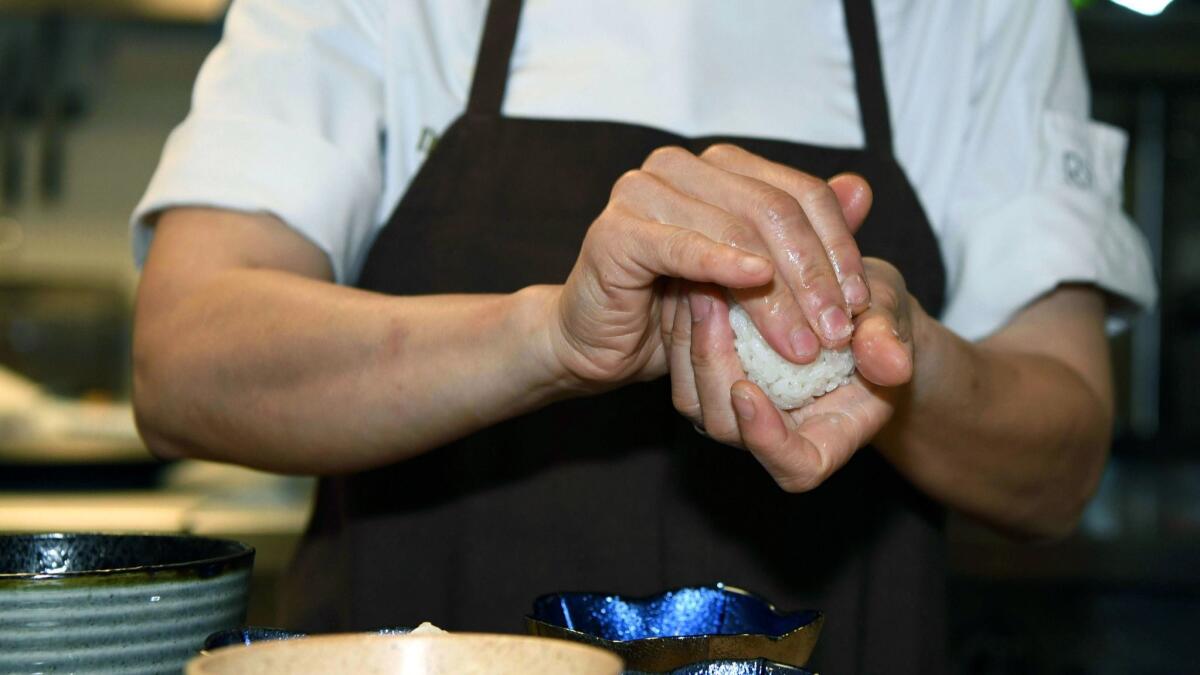
- Don’t pack the onigiri too tightly. Most people have a tendency to over-squish them, says Nakayama. The rice should hold together but still feel a touch loose when you press it.
- The traditional triangle shape is ideal because it is easy to hold and pack in lunch boxes, but you can make other shapes too.
- Pack your nori separately from your onigiri if you’re packing these for a picnic or lunch to maintain its crunch.
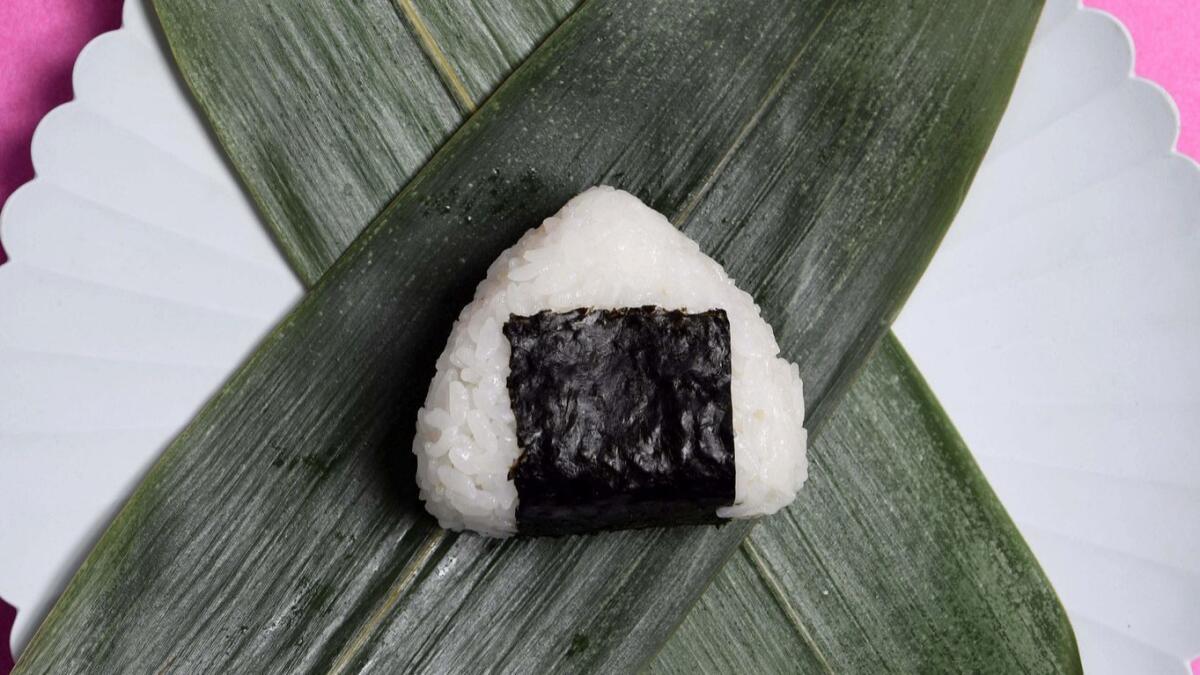
Onigiri
View this recipe in our California Cookbook »
1 hour. Makes 6.
- 1 cup Japanese koshihikari rice
- 1 cup Californian short-grain rice
- 1 ½ cups cold filtered water
- Fillings such as umeboshi, pitted and torn in bits; mentaiko; flaked smoked fish; or tuna mixed with mayonnaise
- Coarse sea salt, preferably Japanese
- Nori, preferably ariake, cut into 3-inch by 6-inch rectangles
1 Set a colander with holes smaller than the rice grains or a sieve in a bowl that holds it snugly. Mix the rice grains in the colander. Add enough cold running tap water to cover by an inch, swirl the rice using your fingers and lift out the colander as quickly as possible. Pour out the water. Repeat until the water is clear after swishing, 4 to 7 times.
2 Shake the rice in the colander to remove excess water, then pour into a small donabe rice pot or medium saucepan. Add the cold filtered water, stir once with your fingers and let soak for 30 minutes.
3 Cover the pot and place over high heat. Bring to a rolling boil, 10 to 12 minutes. The moment the water starts to boil, reduce the heat to medium-low and cook the rice at a steady simmer for an additional two minutes. Remove the pot from the heat and let stand, covered, for 20 minutes.
4 Uncover the pot and let stand until the rice is cool enough for you to work with your hands. The hotter the rice, the easier it is to mold, but don’t burn yourself. Use a rice paddle or flat, wide spatula to gently mix the rice without crushing the grains. You just want to even out the grains and disperse the moisture from the center of the pot.
5 Spoon a paddleful of rice (about 1/3 cup) into a small rice bowl. Drop a teaspoon of filling in the center, then top with just enough rice to cover the filling.
6 To shape onigiri by hand: Rinse your hands with cold water and shake off excess. Sprinkle a pinch of sea salt on the palm of one hand, leaving the salt on the fingertips of your other hand. Turn the rice out of the bowl into the palm with the salt. Use the heel of your other palm and your fingers with salt to gently squeeze and press the rice into a 1-inch-thick triangle shape, rotating the rice as you press it.
7 Alternatively, shape onigiri in plastic wrap: Place a large sheet of plastic wrap on your work surface. Sprinkle a pinch of salt evenly over the rice in the bowl, then turn the rice out of the bowl into the center of the plastic wrap. Bring up the sides around the rice and twist and wrap tightly. Gently squeeze the rice in the plastic wrap to form a 1-inch-thick triangle shape.
8 Turn on a gas stovetop burner to medium heat. Pinch a sheet of nori on one end with your fingers and wave and flap it 3 to 4 inches over the flame until fragrant and slightly crisper, 15 to 20 seconds. Immediately wrap it around the rice and eat as soon as possible.
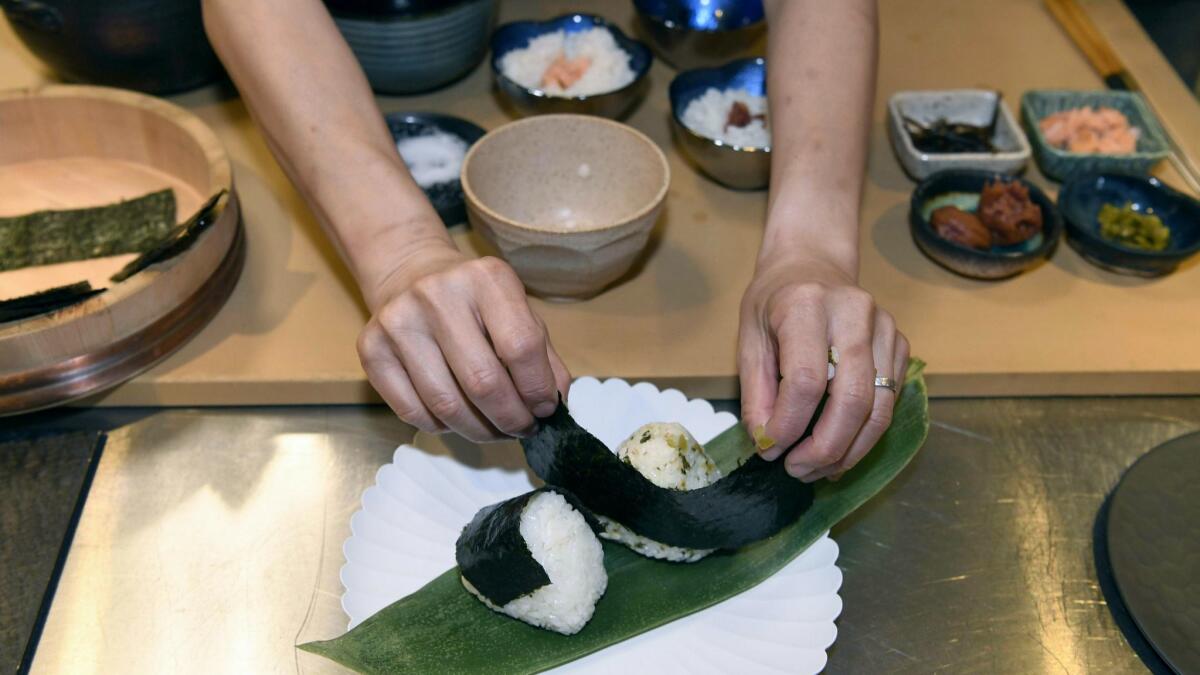
Make Ahead: The rice can be shaped up to 4 hours ahead, wrapped tightly in plastic wrap and kept at room temperature; the nori can be packed separately in an airtight container. If the rice has gotten cold, microwave in the plastic wrap for 30 seconds. Wrap in the nori and eat immediately.
More to Read
Eat your way across L.A.
Get our weekly Tasting Notes newsletter for reviews, news and more.
You may occasionally receive promotional content from the Los Angeles Times.











